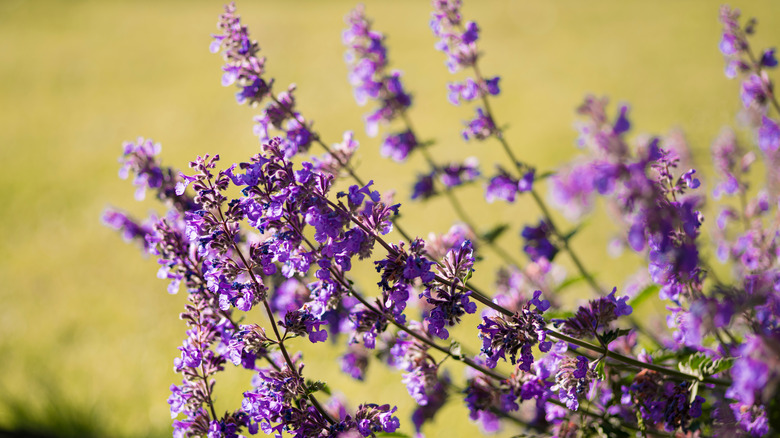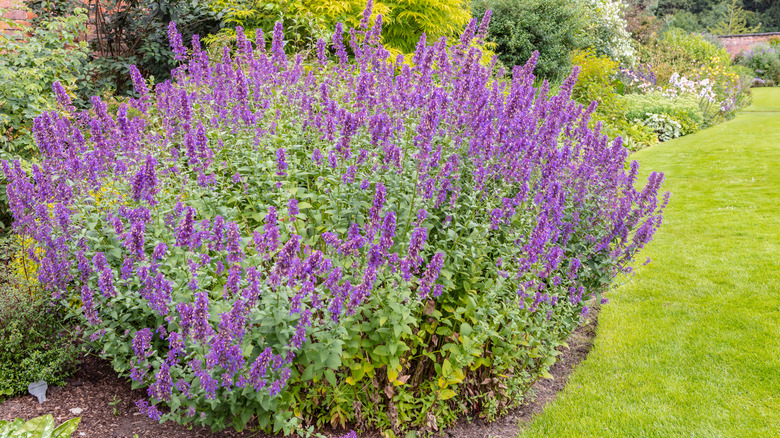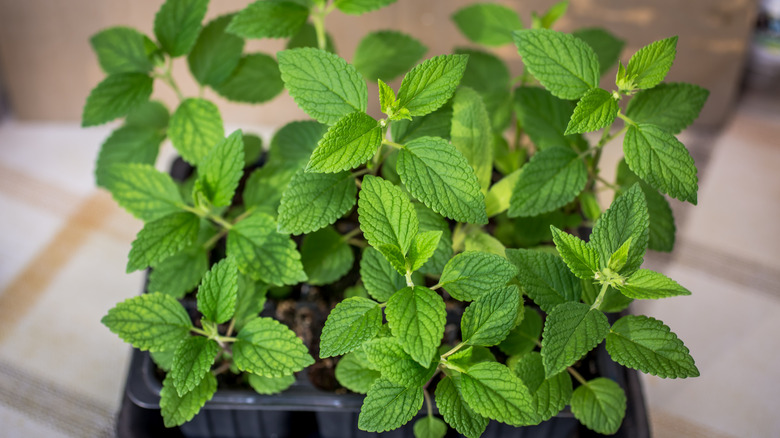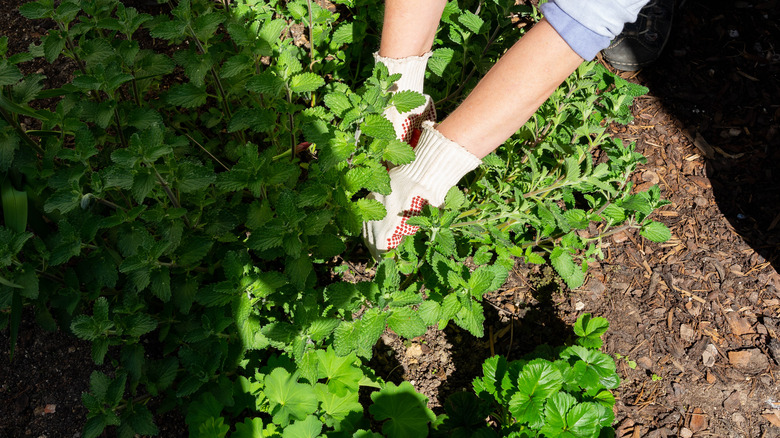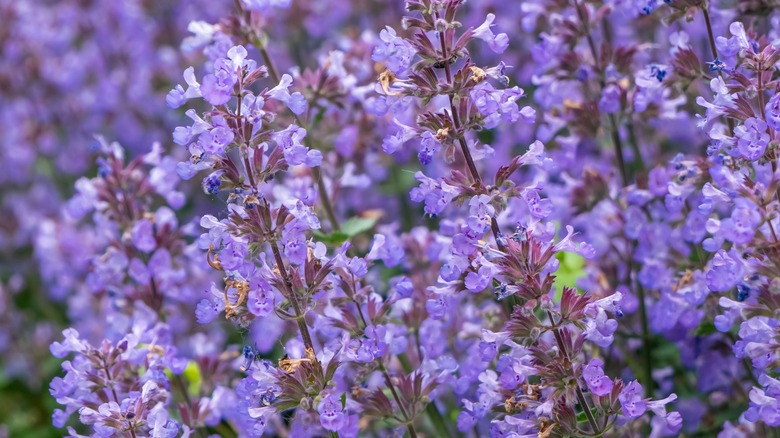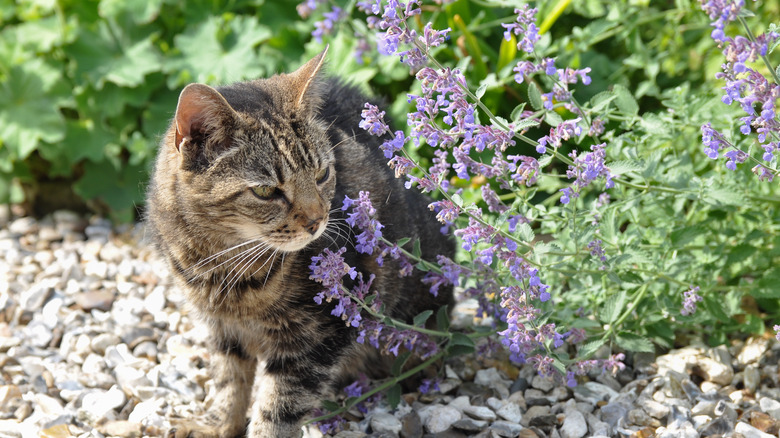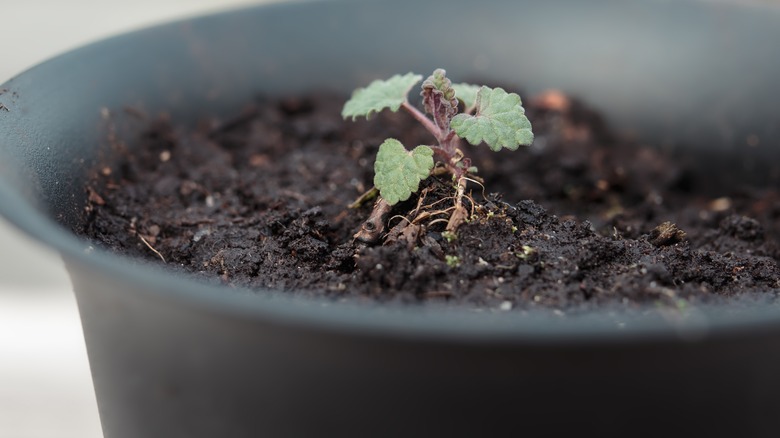How To Care For Catmint Plants
The catmint plant, belonging to the genus Nepeta and a member of the mint family, is an easy-to-grow flowering perennial that you will fall in love with right away. It has dense, aromatic foliage that is known to draw the attention of cats — hence the name 'catmint'. This hardy plant easily adapts to most conditions and has a long blooming season, starting in mid-spring and lasting all the way to the end of summer. It flowers in a range of colors, for instance, lavender-blue, white, or pink depending on the variety.
The catmint plant hails from parts of Europe, Asia, and Africa, but has naturalized in the United States in USDA zones 4-8, according to The Spruce. It has a rich history, and according to Gardening Know-How, it was initially used in herbal teas, or as an insect repellent. The catmint plant is often confused with its close relative, the catnip plant. Belonging to the same genus, the two species share several characteristics, however, the catmint plant is thought to have a greater aesthetic value and is more often used as an ornamental garden plant. Let's dig deeper into the intricacies of growing and caring for this interesting plant.
How to use catmint plants in the garden
The catmint plant makes for a lovely ornamental plant that would make a great addition to anyone's garden. It is imperative to first understand the growing habits of this plant in order for you to decide how to best incorporate it into your own garden. Most varieties of catmint plants have sprawling characteristics, thus making them a good option for ground cover. According to MasterClass, you can also take advantage of its natural, sprawling form by planting them along sidewalks or garden borders.
It is also worth remembering that the catmint plant is deer resistant, so although the plant may attract cats in your neighborhood, you won't have to worry about deer foraging through your plants, even if plant on the furthest edges of your garden. This is just one characteristic that makes catmint an ideal companion plant, particularly for roses. When planted next to your rose bush, the catmint's thick, low-growing foliage provides shelter to the rose's exposed lower stems. In addition, its subtle fragrance also helps repel a wide range of harmful pests, per Gardening Know-How.
How to grow catmint plants
The catmint plant is easy to grow and care for, making it a perfect plant for any beginner gardener. The ideal time to plant outdoors is either during early spring or late autumn. However, if you intend to grow catmint inside your home in a container, you can plant it at any time. Similar to other perennial plants, the catmint plant will grow and blossom for several years. Nevertheless, if you want to make new plants, there are two ways to go about it: propagation by division, or growing them from seed. The Spruce explains that division should be done during spring when the temperatures are fair.
To divide your catmint plant, first look for a plant section with developing shoots and established roots. You can use a spade to detach the section from the mother plant. Go ahead and replant it in the desired location of your choice. Be sure to water the plant for at least 1 month until it is well-established. If you want to grow the plant from seeds, you will need to start them indoors about eight weeks before planting. Cut off the growing shoots after a few weeks to promote a thick and bushy undergrowth.
How to care for catmint plants
Catmint plants don't have any unusual care requirements. This plant loves the sun, so you should pick a sunny location where it will thrive. Planting catmint in well-drained soil will also do them a lot of good. However, catmint is an adaptable plant and will grow in most soil types, provided there is enough organic matter. Another essential care practice is spacing the plants well. The catmint plant grows into a thick bush, and therefore requires enough space in between the plants when growing. Gardeners' World explains that spacing of up to 24 inches is ideal, but it differs depending on the specific variety.
It is also important to provide the plants with enough water, especially during the first year of growth. Be sure to water the plants frequently during the first weeks of planting. They will no longer need frequent watering once they are fully grown and well-established. Catmint plants do not require any fertilizer but you can make sure they receive adequate nutrients by mixing organic manure or compost into the soil during planting.
Catmint plant varieties
There are a number of catmint plant varieties available for planting. While they share many characteristics, they each have subtle differences that distinguish them from one another. Some of the most popular varieties detailed by MasterClass include the following:
-
Six Hills Giant catmint (Nepeta x faassenii): Six Hills Giant is, unsurprisingly, among the taller varieties of catmint, with the capacity to grow up to 3 feet tall. Thus, it requires sufficient spacing when planning more than one plant.
- Japanese catmint (Nepeta subsessilis): This variety from Japan is known for its beautiful violet flowers and complementary, silvery-green foliage.
- Walker's Low catmint (Nepeta racemosa): Hailing from regions of the Middle East, this dwarf variety is among the shorter in size. It reaches just 1 foot in height but makes up in strength what it lacks in stature, as it is one of the hardiest varieties available.
- Blue Wonder catmint (Nepeta racemose): This variety is particularly eye-catching, with its delicate pale blue flowers. It is among the shorter varieties of catmint, growing only 10 or so inches tall.
- Greek catmint (Nepeta parnassica): Indigenous to the Pindu mountain range extending from Greece to Albania, this variety is catmint is unique for it's great height, pink and purple blossoms, and heart-shaped foliage.
Are catmint plants toxic?
Catmint, as its name implies, is very appealing to our feline friends, according to SF Gate. This raises concerns, however, about whether it is actually safe for your pets. Thankfully, unlike some other houseplants, catmint is non-toxic to cats and other pets. Though commonly confused with the closely-related catnip, catmint has a much milder effect on the curious animals. In fact, PetsRadar states that it is nearly impossible to tell whether or not your cat has taken a few nibbles of catmint, especially when compared with the much more dramatic effects of catnip. Despite its non-toxicity, it is important to remember that no plant is entirely safe when consumed in large quantities.
As for humans, the catmint plant is edible and has a history of human consumption over the years in counties like England and China. According to Plan Your Patch, catmint is rarely consumed raw — instead, it is typically steeped in hot water to make an herbal tea. It is used to help manage stress and is also thought to alleviate physical symptoms such as cramps and gastrointestinal distress.
How to repot catmint plants
While most people prefer to grow catmints outdoor in the garden, it is also possible to grow this plant indoors in pots and containers. If you keep your catmint in good health, eventually, you will need to repot it once it grows too big for its current container. According to Plant Instructions, another reason to repot your indoor houseplants is to replenish the plant's nutrients by changing the soil.
To repot, you'll need a spade, fresh potting mix, and a new container one or two inches bigger than the previous one. You also have the option of dividing your catmint into smaller sections, rather than simply repotting and allowing it to grow even bigger. If this is the case, you can keep your current pot and plant the additional sections in their own containers. One rule of thumb to stick by is to water your plant a day or two before repotting. This will help the plant better transition to its new pot.
